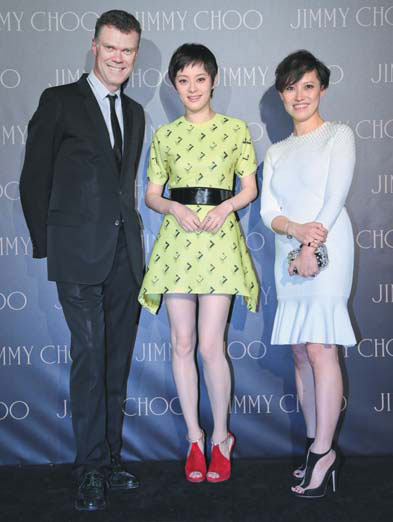Heart and sole of fashion
Updated: 2014-01-26 07:28
By Xu Junqian(China Daily)
|
|||||||
|
A collection of Jimmy Choo's signature shoes throughout the past decades is displayed in Shanghai in November. Photos Provided to China Daily |
|
(From left to right) Jimmy Choo's CEO Pierre Denis, actress Sun Li and the brand's creative director Sandra Choi appear at the opening of the Shanghai exhibition. |
|
Jimmy Choo's 10-centimeter heels. |
Sandra Choi has shown a clean pair of heels while making her way in a competitive, male-dominated industry. Xu Junqian reports in Shanghai.
It seems more than natural that the creative director of luxury shoe brand Jimmy Choo is wearing 10-centimeter heels. She grew up with the sit-com Sex and the City, in which the famous line from Carrie Bradshaw, "I lost my Choo", became the best advertisement for the 19-year-old shoe house.
But for Sandra Choi, the creative director, or designer-in-chief of the brand founded by her uncle Jimmy Choo in an old hospital building in London in the 1990s, the brand has more to offer than sexy high heels or glamorous "TV shoes".
And to prove that, the Chinese woman born in Britain brought a collection of the brand's signature shoes throughout the past decades to Shanghai and Beijing for an exhibition in November, titled Signature.
The iconic sandal, named Feather, was "lost" by Carrie in the TV show. There are altogether 10 classic pairs on show, each followed by a string of the names of Hollywood actresses who have worn them, mostly on the red carpet.
"I don't think the word comfortable is very sexy," says Choi about those at least 10 centimeters on display, each of which are beautifully and carefully presented on a crystal-clear glass box under the spotlight.
And it's a lesson perhaps learned even before her days at Jimmy Choo. Choi has been with the brand almost since Day 1, helping her uncle like an intern.
"I have always loved fashion," she recalls. "I grew up in Hong Kong. At the age of 11 or 12, I started discovering Japanese magazines, flicking through them and wanting to become a Japanese pop star. That's very teenage."
After she got back to England where her parents worked and lived, the strange all-English-speaking environment pushed the Cantonese-speaking girl more into the non-language-involving subjects, such as math and art.
But it was not until around the age of 15 and 16, during the 1980s, when a piece of John Galliano's Vogue show with his deconstructed jacket that she decided to turn her interest to something serious, if not a lifelong career. That was also when she moved to London and lived with her uncle Jimmy and her aunt.
Unsurprisingly, the decision was not much understood by her parents, who don't think "one can make a career out of making clothes", though the two restaurateurs are big fans of art and creative things.
Choi remembers that during the early days, when she was speaking to her mother about going to Los Angeles, covering the Academy Awards and dressing the celebrities, all her mom said in response: "What does it have to do with you?".
But before the foundational course got serious, the only hand at the mom-and-pop store had been "too engaged" in all kinds of work, making shoes, picking up the phones and speaking to stylists who wanted to borrow shoes. As a result, the then 19-year-old quit school after six weeks and worked full time, thinking she could always go back to school later, though she never did.
One of the "amazing things" that kept her "drawn to the industry" for decades is that, as a female in the male-dominated shoe-making industry in Italy, where most of the Jimmy Choos have been made, she got to make shoes in the way she believes they should be produced.
"Thinking about doing certain things, and it happens, and happens through collaboration, is appealing, and I still love it," as she puts it, joking that otherwise she "would not be sitting here" (in the sprawling Jing'an Suite of the dubbed urban resort Puli Hotel in downtown Shanghai).
The tough, or the not so "lovable" part, of the job, for the designer - who seems overwhelmed with, rather than out of - ideas, is to make a choice for every seasonal collection. Everything in life - a trip, a photo or even an hour in a streetside cafe watching people - is inspirational for her.
There is always the thought that, "if I hold this back and shift it to another collection, would I miss that slot". But at the end of the day, she consoles herself with the thought, "it's still business", aside from all the fantasy and creativity.
Contact the writer at xujunqian@chinadaily.com.cn.
(China Daily 01/26/2014 page7)


